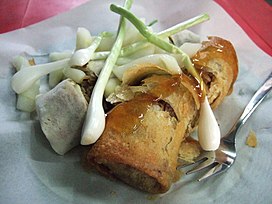Lumpia

Fresh, unfried lumpia fillings (left) and fried lumpia (right)
|
|
| Alternative names | Loempia, Loenpia, Ngohyong |
|---|---|
| Course | Main course or snack |
| Place of origin | Indonesia and the Philippines |
| Serving temperature | hot or room temperature |
| Main ingredients | wrapper, meat, vegetables |
| Variations | Fried or fresh |
| |
|
Lumpia is a spring roll of Chinese origin commonly found in Indonesia and the Philippines. It is a savoury snack made of thin crepe pastry skin called "lumpia wrapper" enveloping a mixture of savoury fillings, consists of chopped vegetables (carrots, cabbages, green beans, bamboo shoots and leeks) or sometimes also minced meat (chicken, shrimp, pork or beef). It is often served as an appetizer or snack, and might be served deep fried or fresh (unfried). Lumpia is quite similar to fresh popiah or fried spring rolls popular in Southeast Asia.
In Indonesia lumpia has become a favorite snack, and is known as a street hawker food in the country. In the Philippines lumpia is one of the most common dishes found in any kind of gathering celebration.
In the Netherlands and Belgium, it is spelled loempia which is the old Indonesian spelling for lumpia and has also become the generic name for "spring roll" in Dutch and French. A variant is the Vietnamese lumpia, wrapped in a thinner piece of pastry, in a size close to a spring roll though, the wrapping closes the ends off completely, which is typical for lumpia. In Venezuela, it is spelled "lumpia" and was introduced by the Chinese who migrated to South America.
The term lumpia derives from Hokkien lunpia (Chinese: 潤餅; pinyin: rùnbǐng; Pe̍h-ōe-jī: jūn-piáⁿ, lūn-piáⁿ), which is an alternate term for popiah. Spring rolls of different shapes, sizes and fillings have been a popular snack in East Asia and Southeast Asia for centuries. It is believed that the spring rolls are originated from China. It was a seasonal food consumed during the spring, started as a pancake filled with the new season's spring vegetables, a welcome change from the preserved foods of the long winter months. The recipes, both fried and fresh versions, were brought by Chinese immigrants from the Fujian province of China to Southeast Asia and became popular when they settled in Indonesia and the Philippines.
...
Wikipedia
